
Text © DrSc Giuliano Russini – Biologist Zoologist

English translation by Mario Beltramini
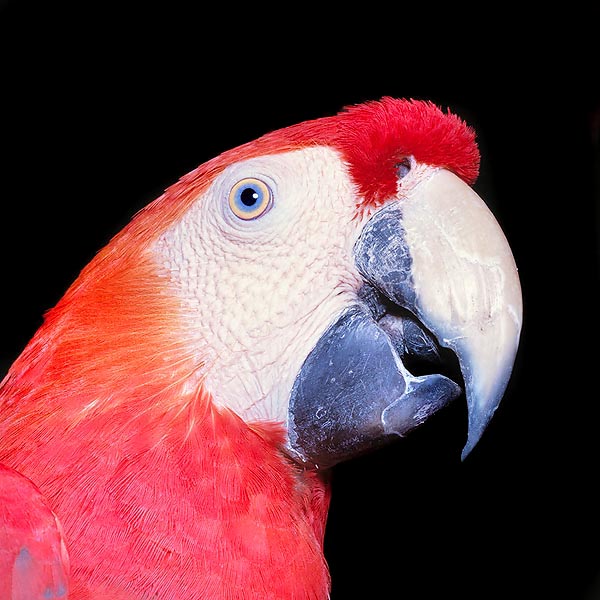
Ara macao © Giuseppe Mazza
►Family Strigopidae
– Subfamily Strigopinae
– Subfamily Nestorinae
►Family Cacatuidae
– Subfamily Nymphicinae
– Subfamily Cacatuinae
►Family Psittacidae
– Subfamily Psittacinae
– Subfamily Arinae
– Subfamily Psittrichasinae
– Subfamily Coracopseinae
– Subfamily Platycercinae
– Subfamily Psittacellinae
– Subfamily Loriinae
– Subfamily Agapornithinae
– Subfamily Psittaculinae
The Psittacidae, the parrots in the strict sense, represent a wide family of birds belonging to the order of the Psittaciformes (from “Ψιττακός” , “psittakos” = parrot, in Greek). They were studied in detail by the German biologist zoologist and entomologist Johann Karl Wilhelm Illiger, professor of zoology and director of the Natural History Museum of Berlin, who described 25 species of them in the tropical and subtropical areas, during his trips in Amazonia and in Africa, between the years 1795 and 1811.
In the past, the Psittacidae, the Cacatuidae and the Strigopidae were included in the same family, but they are now placed in two distinct families, which, together with the Loriidae (nowadays they prefer to talk of subfamily Loriinae) form the order of the Psittaciformes.
This because, even if Psittacidae, Cacatuidae and Strigopidae have common characteristics (robust bill bent downwards, reproduction areas and ways of nutrition, zygodactyl feet, with one pair of toes directed backward and the other forward, each, etc.), the differences are more numerous than the similarities, and the scientific community has met the necessity to separate them, as it results from the ICZN classification.
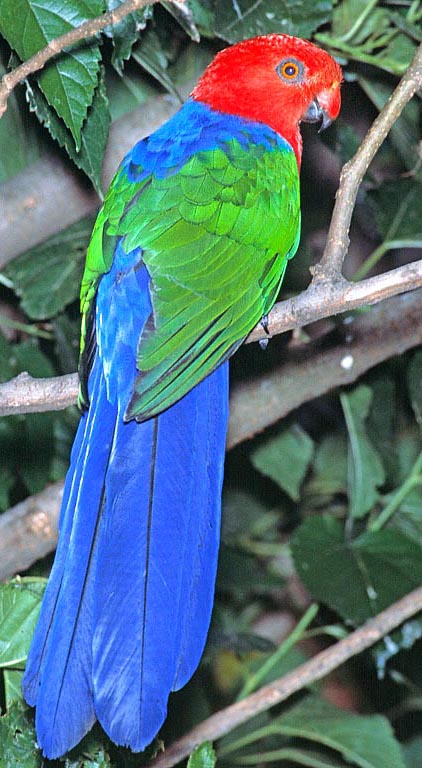
Alisterus amboinensis © Giuseppe Mazza
As a matter of fact, Cacatuidae do have sexual dimorphism, and have a usually monochromatic colouration, white, pale pink (hypomelanism), dark (melanism), or dichromatic, with a showy erectile crest, spotted at times, over the head, which the bird can open or close at its own will, and have a different geometric composition of the plumage, without the reflections and the bright colours of the Psittacidae due to the absence of Dyck texture.
And also the biologists Brown and Toft in 1999, seen the morphologic and somatic aspects and the data of the mithocondrial 12S rRNA sequency, which clarifies its phylogenetics, have concluded for this separation.
The Psittacidae differentiate also under the anatomic-physiologic aspect, as they do not have the gall bladder, digestive gland closely connected to the liver, which is of use in the emulsion of the fatty acids.
The name Cockatoo comes from the Malay word kaka(k)tua (form composed by kaka: “parrot” + tuwah: “older sister”) and the family of the Cacatuidae counts the genera Probosciger, Callocephalon, Nimphicus, Calyptorhynchus, Eolophus and Cacatua.
We can distinguish 3 subfamilies:
The one containing the Cockatiel (Nymphicus hollandicus), the only species attaining to the subfamily Nymphicinae, markedly different to the other cacatuids.
The Black cockatoos, which belong to the genus Calyptorhynchus, the only one representing the subfamily Calyptorhynchinae, which have dichromatism and great concentrations of melanin in the plumage. The wings, tail and face can be red, yellow or even orange in both sexes. In some species the females have their tail and wings striped and a yellow or white dot on the temporal-occipital region, which the males do not have, sign of chromatic sexual dimorphism.
The last subfamily, Cacatuinae, contains two tribes: the Microglossini, which is only represented by the Palm cockatoo (Probosciger aterrimus), which is black as those in the previous subfamily but show very little sexual dimorphism, exactly as those in the other tribe, the Cacatuini, that are, instead, hypomelanic, thus showing brighter and showier colours like, for example, the splendid Salmon-crested cockatoo (Cacatua moluccensis).
At present, a discussion is going on whether the other extant lines, Lorees and Lorikeets, can be considered classifiable as separate lines, or considered as belonging to the family of the Psittacidae, but there are still no certainties about this matter from the Commision for Zoological Nomenclature (ICZN). The Lorees and the Lorikeets (family Psittacidae, subfamily Loriinae) are a group of even 55 species spread over the ocean habitat comprised between Sulawesi and the Philippines up to Tahiti and the Fiji Islands through Australia and mainly New Guinea, Maluku and Solomon Islands, where most of the species do live.
They are noteworthy birds, great eaters of nectar and therefore furnished of a brush-like tongue with which they can efficaciously clean up the interior of the flowers, completing their diet also with fruits and insects. They are coloured, often of bright red, or cobalt blue, or green at times, and their size varies from 8 to 35 cm. Gifted with a very strong and characteristic voice, with an aggressive attitude, they are curious and prone to exploration. They are very problematic birds, due to their particular diet and their breeding. A classical example of Lori is the Rainbow Lorikeet (Trichoglossus haematodus), which can reach a length of 26 cm and about the 35-40 years of life. It has a green plumage, red front, naked and white, edged of small black plumes, cheeks, black beak, yellow iris, azure belly.
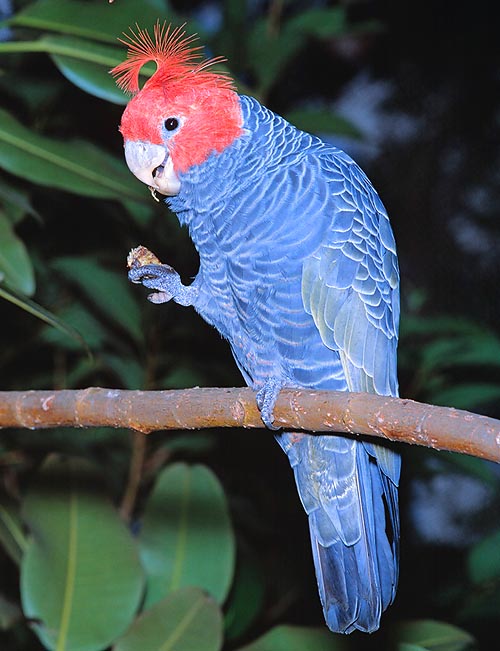
Callocephalon fimbriatum © Giuseppe Mazza
It is a noisy, active and curious species which can be very aggressive towards its conspecific. In the wild, they have a gregarious life in several very ample groups. Only during the period of mating small groups are created. At times, several hundreds of birds are observed on the trees, looking for food. It is a noisy parrot mainly when different species are associated in community.
Their diet is formed by nectar, flowers, fruits, berries, pollen, seeds, sprouts, insects, larvae, but they can cause damage, even considerable, on the orchards and the fields of wheat.
Endangered species, even if at lower risk if compared to the Ara macaws and the Cockatoos, as per CITES.
The biologic origins of the Psittaciformes are very old, they think that they have appeared on the earth about 50 millions of years ago and that they were characterized by a wide-spectrum zoogeographic distribution, and in fact, they were present also in Europe, where, by now, they are not any more autochthon since several millennia.
The widespread family of the Psittacids (Psittacidae) has developed during the Early Miocene, and has 340 species, of which 317 still extant, distributed in 69 genera.
Fifteen species have extinguished in recent times, and four before the extinction of the Dodo (Raphus cucullatus , frugivore and flightless bird, emblematic victim of the human pressure on the habitat, which extinguished during the second half of the XVII century in the island of Mauritius with the arrival of the Portuguese).
The group, which probably originated in Australasia, has as ancestor the Archaeopsittacus (fossil remains of this have been found also in France), and reveals rather homogeneous, even if in the variability of the colorations of plumage and sizes, which vary from a length of little more than 5 cm and one metre of length and more. We can, in fact, go from the Hyacinth Ara (Anodorhynchus hyacinthinus)which can reach the 100-120 cm of length, with wing span of 120-130 cm, and a weight of 1,4-1,8 kg, to reduced dimensions like those of the so called budgies, the Common Pet Parakeets (Melopsittacus undulatus), weighing few grams and 5 to 18 cm long.
A special case is the Kakapo (Strigops habroptilus), the heaviest parrot and the only one unable to fly and together with the two species of Nestor (Nestor notabilis and Nestor meridionalis) form the family of Strigopidae, parrots autochthon of New Zealand. Like other ratite birds, that is not suitable for flying (like the struthioniformes, galliformes, casuariformes and rehiformes) it has in fact short wings and has no keel on the sternum, typical skeleton structure of the flyers, where the robust pectoral muscles, necessary for the flight, join, projecting from the thorax to the wings. Its weight varies between 3-4 kg, and utilizes the wings as a balance helm, when it jumps from the branches, for reducing the falling speed toward the ground. It is also the most long-living member of the class of the Aves, with a certified average life of 90 years.
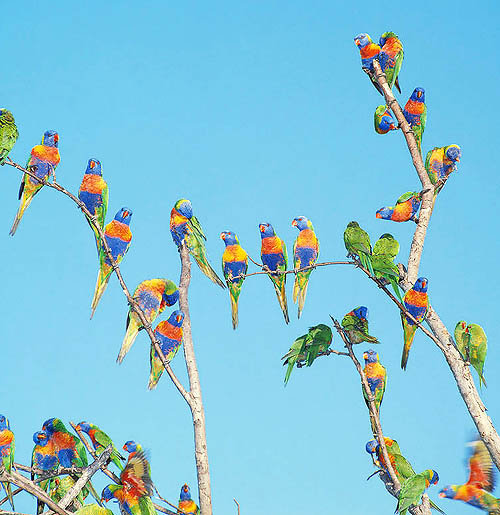
Trichoglossus haematodus © Giuseppe Mazza
Among the very known parrots, autochthon of the pluvial-tropical forests of South America (Amazon forest, Brazil: Mato Grosso, Parà, Piaui’, Marhano and Tocantisest forests of Bolivia, like those of the department of Santa Cruz de la Sierra, whilst in North Paraguay in the department of Concepcion, in Venezuela, Panama, Colombia, Mexico, Guyana, up to the island of Trinidad), we find the members of the genus Ara , like the previously cited Hyacinth Ara (Anodorhynchus hyacinthinus).
This species, diffused south of the Amazon River, has a cobalt-bleu plumage, darker on the wings, contour of the eye and base of the mandible naked and yellow, very big black beak, brown iris. Very long-living, it can be more than 80 years old. Others are, for instance, the Military Ara (Ara militaris militaris), from Mexico to Panama, with its military-green plumage along the body, red front, naked cheeks, white, edged by small black feathers, black beak, yellow iris, azure belly, also this is a species which can live long time, it can reach the 70 years, and can be 75-80 cm long.
The Blue-and-yellow Ara (Ara ararauna), spread from Panama to Argentina, has a very long tail, but the whole length head-tail does not overcome the 90 cm. It has a bright blue coloration on the back, the wings and the occipital portion of the head, whilst the thorax and belly are yellow and the remainder is green. Black beak, and in the part of the face between the base of the beak and the eyes, there is a horizontal black-white band.
And the showy Scarlet Ara (Ara macao), is autochthon of the humid evergreen forests of tropical America, from the eastern extremity of Mexico to Peru and the Amazon Brazil, in the lowlands up to 500 m of altitude, even if there have been observed, sporadically, specimens towards the 1000 m. It is 81-96 cm long, more than a half concern the tail, sharp and graduated, typical of all the Aras. The average weight is around the kilo. The plumage is mainly scarlet, but the feathers on the back and of those covering the tail are pale-blue, the great upper covering plumes are yellow, the lateral sides of the flight feathers are dark blue, as well as the extremities of the feathers of the tail.
Substantially, the Psittacidae are endemic to the equatorial and sub-equatorial pluvial forests of South America, Asia and Africa, whilst the members of the Cacatuidae family and of the Loriinae subfamily and the Strigopidae, besides these regions, in lesser density, do live, on the contrary, mainly in Oceania, Far East, Hawaiian archipelago, Fiji islands and Philippines archipelago. Even if, as we have seen, the Psittacidae have much variable colours and size, with 23 giant species, like those afferent to the genera Ara and Amazona, which stand also among the most beautiful birds in the world, the group shows a clear physiological-functional homogeneity. They have an analogous alimentary ecology, a similar reproductive physiology (number, size of the eggs, typology of the brood and characteristics of the nest), and common nuptial customs.
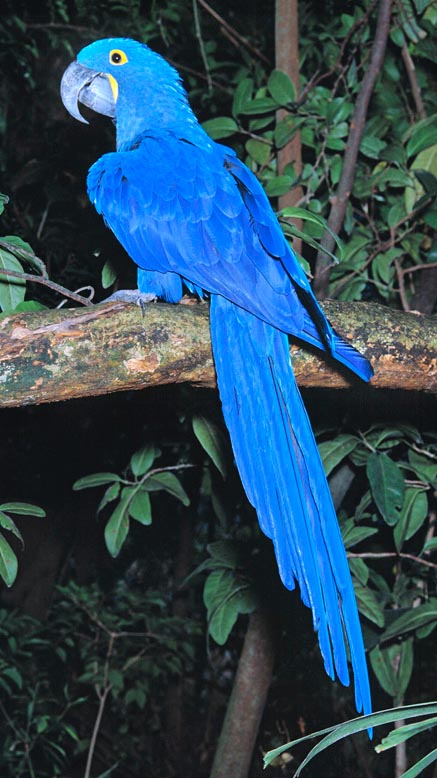
Anodorhynchus hyacinthinus © Giuseppe Mazza
Constant morphologic characters are the presence of a big head, linked to a short and bulky neck; a particularly developed, robust and hooked beak; claws with zygodactil foot, where the second and third toes are directed forward, the first and forth backward thus to allow an easy grip on the braches of the trees; the upper part of the beak mobile as to the bones of the skull; the tail composed by 12-14 flight feathers; the presence of “feather-dusters” spread all over the body, called also powder-puffs which produce a very thin, white, unctuous to the touch, powder, which spreads on the plumage coming from the terminal cells of the barbs which crumble and fragmentize after having reached a certain development.
These feathers replace functionally a gland (typical in other birds, mostly the aquatic ones: marshes and sea) called Uropygial or Preen gland, absent in the Psittaciformes, which has the function to secrete the sebum, an oily substance which renders the plumage waterproof.
Finally, another common character is the presence of a fleshy membrane at the base of the beak, where the nostrils open. Also the habitude of these animals of a more arboreal life and their reproductive physiology are also homogeneous.
In this regard, we describe here below the feminine and masculine reproductive system which is equivalent in the Psittacidae, in the Cacatuidae and in the Strigopidae.
In the males, the two testicles (which are inner), are small and ovoid and are located close to the cephalic portion of the kidneys.
Like most of the birds, the Psittaciformes are not provided of an erectile phallus for the copulation, but only of an extro-flectible cloaca, which they place in contact to the female one, in order to allow the semen to pass during the mating. The rare birds having a cloaca equipped of an erectile phallus, belong, in fact, to older orders, such as the Struthioniformes and the Anseriformes.
During the reproductive period (as it happens for the ovaries of the females), in order to render the coupling more effective, the testicles can increase their dimensions from 200 to 300 times, under the effect of the testosterone and its metabolic by-products.
These capacity of the gonads to increase and reduce their volume, turns out to be a winning evolutionary strategy, as it allows the birds, once the coupling time has passed, to reduce their weight and to fly better. The reproductive system of the female, is, first of all, characterized by the fact that only the left ovary and its oviduct are biologically developed and operational. The right one is atrophied, like for most of the orders of birds. Only in the falconiformes there can be also the development of the right ovary, which, nevertheless, is not operational physiologically.
The oviduct is subdivided in five regions. An Infundibulum Opening, with an entrance funnel-shaped ostium, which receives the mature oocyte coming from the ovarian follicle, the opening of which is regulated by the estrogens during the reproductive season. A second tract of the oviduct, called Magnum, where is secreted most of the albumen surrounding the egg under formation. A third tract, the Isthmus, secretes the materials and the calcareous substances charged of the formation of the shell membrane. A fourth region, the Uterus, where the egg is received, other albumen is laid (the most external shell), a membrane covering the inner part of the shell, some more limestone for the same, and are elaborated the pigments (in the case of the orders of birds where the eggs are coloured) of deposit in the shell. In the case of the Psittaciformes , the eggs are usually white. The last region is the Vagina, rich of mucous glands and a strong muscular Structure, which is of use for the expulsion of the egg during the brood. Usually, Psittacidae, Cacatuidae and Strigopidae spawn round eggs, white or slightly pink, in high quantity, often 3 to 10 per brood.
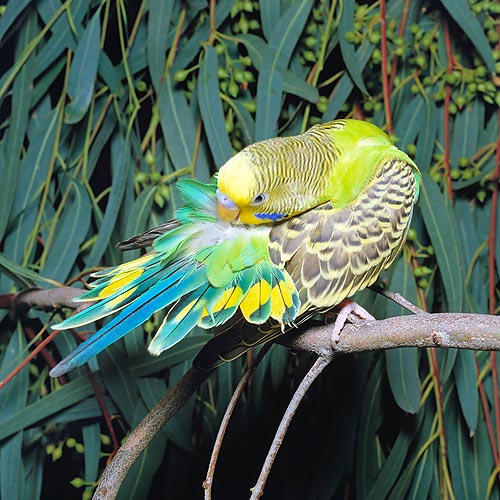
Melopsittacus undulatus © Giuseppe Mazza
As it happens for most of the Reptilians, these are Cleidoic, that is with rigid shell, porous, which allows the gasseous exchanges with the atmosphere, protecting, inside, the development of the embryo. A winning structure for the external reproduction, which has permitted the reptilians and birds to conquer the terrestrial and sub-aerial habitat.
Later on, with the mammals, the evolution has created the conditions for the internal reproduction: completely intrauterine, in the placentate mammals, and partly uterine and partly in an incubating pouch, in the marsupials.
In the Psittaciformes, usually, the number of the eggs is inversely proportional to the dimensions of the bird. The greater it is, the less is the number of eggs produced; the smaller it is, more eggs are in the nest.
This is built, depending on the cases, in dens into the ground, in fissures in the rocks or also in cavities of the trees. Some species dig their nest in the termite mounds; others, like the Monk Parakeet (Myopsitta monachus), unite in groups for building up a high number of nests, all on the same tree. Groups which, at times, reach such a quantity to break the branches.
The brood, cared by the female, lasts for an average of 20 days, but can be shorter, or long more than a month, depending on the species.
When hatching occurs, there well be an altricial-inept issue, opposite to the apt-presocial, typical of the ratite birds, as happens in the Galliformes (Gallus gallus domesticus or the turkey Meleagris gallopavo), in the Struthioniformes (Struthio camelus), in the Casuariformes (Casuario bennetti), in the Rehiformes (Rhea Americana) etc., where, by the opening of the eggs, the chicks are autonomous for the nutrition and for walking. Species which, for this reason, are also called nidifugous.
In the case of the altricial-inept progeny, like in the Psittaciformes and in most of the birds apt for the flight, the chicks must be, on the contrary, nourished through regurgitation of the food from one or both parents (here usually, it’s the father who takes care of this), and are not capable to fly or deambulate. They remain in the nest for a part of their life, and for this reason they are called nidicolous.
The Psittaciformes come to life hairless, immature in their skeletal structure, and have a pale tint, also the beak and the claws. In a few days, they get the body and the head covered by a light plumage, ephemeral, which precedes the mature one. The sexual maturity (which can vary from 3 to 5 years, depending on the species and on the specificity of the sex), is coordinated with the maturity of the complete and final plumage. The female broods its young, mainly during the night, as during the day it gets ready for the nutrition and for the game activities.
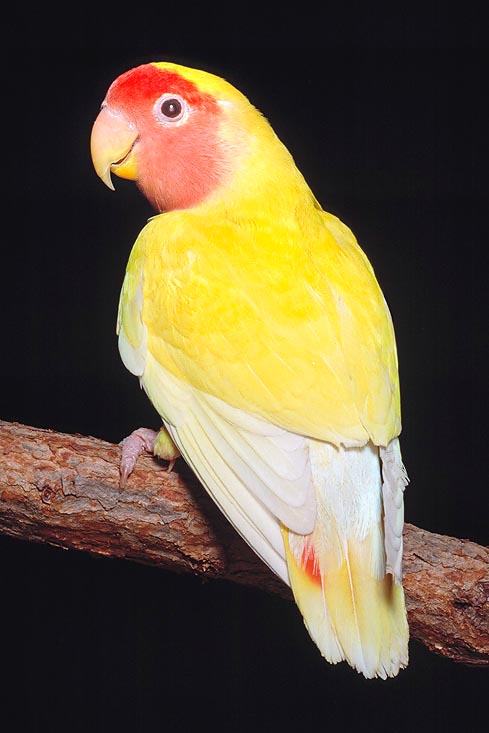
Agapornis roseicollis © Giuseppe Mazza
Many species of parrots have been put in danger, during the last recent years, not only for their beauty, but also for the capacity the have to imitate the human voice and other sounds. An intense, stupid chase has taken place, for taming them, as it happens for the Common Hill Myna, belonging to the Starling family.
It has been maintained that the parrot does not understand at all what it translates in voice or sound. From an attentive etho-physiologic study, it comes out that it associates words and sounds to the events and the persons, in the same way as a two years old child does.
Other ethologists believe that the parrot, good imitator when tamed, would not imitate anything if in the wild. Others, that it talks for “love reasons”, adapting itself for overcoming the loneliness, to the human language. These hypotheses are not easily verifiable.
In the Psittacides, the sexual dimorphism practically does not exist on the morphologic point of view. Often, for sex determination of the animal, they utilize either laparoscopic techniques, or DNA analyses of the plumage or from the analysis of the cariotype (structure, number and size of the chromosomes), keeping in mind that in the birds the heterogametic sex is the feminine one with two heterochromosomes (sexual chromosomes) WZ, the homogametic one is the masculine with two heterochromosomes ZZ, similarly to the lepidopterans and some reptilians.
While in the mammals the heterogamety is masculine with heterochromosomes XY and the homogamety is feminine with heterochromosomes XX.
The nutrition and the alimentary ecology have shown that these animals are frugivorous, granivorous (fresh and dry seeds) and phytophagous. Their gastric intestinal system has therefore a general anatomic-physiologic line similar, in many species, to that of other birds having the same alimentary diet.
In detail it consists of mucous glands located in the mouth, suitable for lubricating the incoming food (alimentary bolus), mainly the dry one, such as seeds.
The Oesophagus is a muscular duct formed by mucous glands and enlarged at the base in a crop, called Cropsac, with the function to store food, rapidly swallowed, for being later on, digested. This allows the bird to eat quickly, in order to be exposed to possible predators for a very short time. No digestive process don’ t begins either in the Oesophagus or the Cropsac. This function is specific to the Stomach, which, in these birds, is divided in two parts, with sizes varying upon the species.
Its front part is called Proventriculus, or Gland Stomach, its wall is not much thick and is formed by glands charged of the elaboration and secretion of hydrochloric acid (HCl), called Oxyntic glands and by glands producing and secreting proteolytic enzymes; here take place the processes of chemical digestion of the aliments, where, with an extremely acidic pH, around 2, all kinds of seeds, and also bones of vertebrates, conch shells, etc., are digested.
The rear part of the stomach is called Gizzard, its walls are thick and muscular, and for this reason it is also called Muscular Stomach. Inside, take place the milling and grinding of the food, it is more developed than in the phytophagous, granivorous birds, which often swallow down also pebbles and sand, which, once inside the Gizzard, will contribute to its trituration.
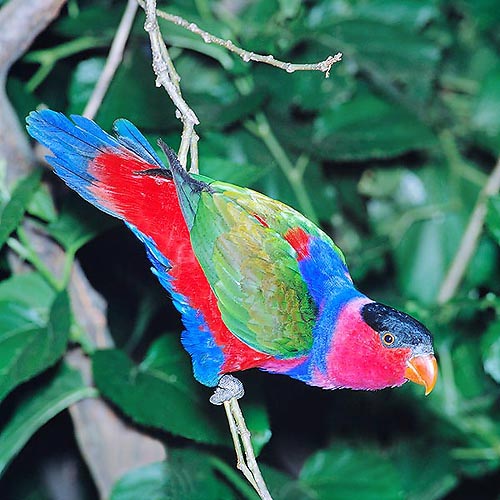
Lorius lory © Giuseppe Mazza
The intestine, unlike mammals, does not have a clear distinction between small and large, but in the point where this anatomic passage would happen, the birds have a couple of Ceca or blind Diverticula, having the function to reabsorb the water from the alimentary chyme.
Finally, the faecal contents of the ceca, being almost waterless, as the water has been reabsorbed, is eliminated separately from that of the other faeces, and has an intense black colouration. It has been calculated that one cecal evacuation happens every ten faeces ejections.
In the mean time, in the birds, there is also another device reducing the loss of water, as they are called Uricotelic organisms (that is, producing Uric Acid, or Urate), which is the most useful chemical formula in which the urine is eliminated, for two reasons of physiological and ecological order.
The first, because the Urate is much easier to concentrate (allowing an better reabsorbtion of water and with reduced energetic consumption) of the Urea eliminated by the mammals, man included (and it is for this reason that they are called Ureotelic organisms), the second is that the Uric Acid is much less toxic to be released in the terrestrial habitat, than the Ammonia (NH3), utilized by Fish and Amphibians, called Ammoniotelic, which, releasing it in the water, guarantee its dilution.
As it seems, animals and plants have a regard for the habitat where they live and respect it, the same cannot be always said for the human beings. In conclusion, we say that the Birds urinate solid (the yellowish-white portion), which is seen in their excrements.
Finally, the intestine ends up with a Cloaca, split by cartilaginous crests in a front part for the faeces, called Coprodeum, one intermediate for the urinary and genital products, called Urodeum, and one on the back, for the final accumulation of the faeces and their ejection, called Proctodeum.
The digestion in the birds is very fast, this is good for avoiding that during their flight they increase their body weight with excessive alimentary masses, which would cause a great energy consumption.
The Cardiovascular system is complete and double (that is, there are a venous and an arterial component, autonomous and separate), the heart is formed by 4 cavities (2 atria and 2 ventricles) separated by anatomic-functional septa (interventricular septum, interatrial septum), there are two couples of valves (an atrioventricular couple, and one couple in charge of the connection and regulation of the blood flux from the myocardium towards the systemic and pulmonary circulation).
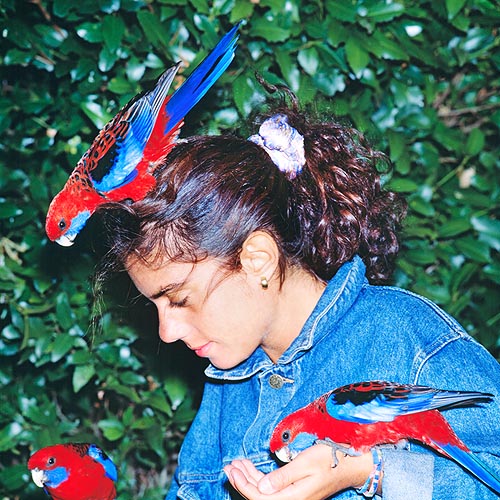
Platycercus elegans © Giuseppe Mazza
The respiratory system is composed by a pharynx, larynx, continuing with a trachea ramified in two pulmonary blind sacs which, however, expand (unlike mammals and other vertebrates), in Air Sacs present all over the body, which store air rich in Oxygen (O2); these volumes will be stored in the pulmonary sacs during the phase of expiration, so that there is always air rich in O2, so that all the organs (therefore the muscles in charge of the flight) are always guaranteed of the physiological contribution of O2 through the gaseous exchanges with the blood present in the pulmonary circulation.
The living area of the Psittacides can reach remarkable dimensions, even of the order of the 57 km2, but, as always, the human being has been able to complicate the life to all these wonderful animals, like the deforestation, narrowing their vital spaces. Nowadays, many nations regulate or even forbid the import of parrots caught in the wild. Most of the species found presently on the market are therefore perfectly naturalized.
The so-called Psittacosis is one of the par-excellence pathologies borne by the parrots and other birds having a zoonosis behaviour, that is, of a disease that can be transmitted by the animal to humans (the pathogenic agent is Chlamydophila psittaci, formerChlamydia psittaci), a small intracellular parasitic bacterium, described for the first time in 1907, an at that time erroneously considered as a virus due to its incapacity of growing in artificial cultivation media. However, it should be noted that even if in some instances this has occurred, actually this disease which infects the lungs has a quite different origin, in fact, most often, the bacteria strains infecting the psittaciforms come from domestic animals, mainly pigeons. So much so that nowadays we, rightly, do not talk of Psittacosis, but of Ornithosis, that is, of infection transmitted by birds in general. It has been proved, at least in very many cases, that if the parrots are not carriers of this pathogenic agent, they have been in their turn infected by other domestic animals.
The scrupulous cleanliness, the right alimentation and usually all the cares for keeping the parrots in good health (with a constant veterinary control), are also an element of security for their owners and form the guarantee, almost absolute, for avoiding unpleasant infections. It will be the case, of course, to avoid those excesses of confidence with the animals, unluckily frequent in the case of parrots, for which our guests get in touch too often with us. Nevertheless, mainly with the kids, if we shall observe that minimum quantity of hygienic measures which we should always have to observe with other living beings, the risks of infection, of whatever type, will be absolutely negligible and by sure not greater than those we can have approaching persons suffering from colds, flue or other infective diseases.
